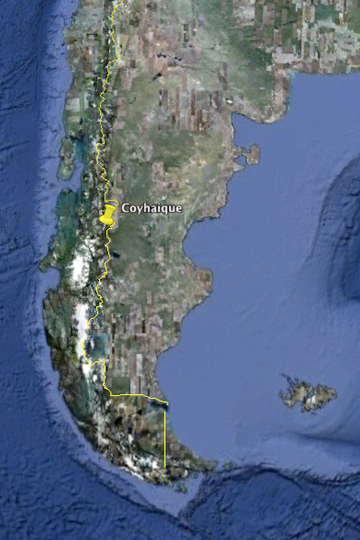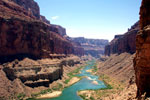The wild rivers of Patagonia may soon never be the same. Last week, Chile’s Aysén Environmental Review Commission approved the environmental assessment of a five dam proposal on two rivers. The approval, however, is marred in controversy and has set off protests in many cities, including Santiago. Critics say the series of dams will destroy a largely untouched region of Patagonia.
Protests hit Coyhaique, the city where the vote occurred, with over 1,000 people marching. Clashes with police resulted in water canons and tear gas being used on protestors. Reportedly protestors were throwing rocks at commissioners’ cars. Dozens were arrested. Similar clashes occurred in Santiago.
Before the approval and violent clashes, public opinion had turned against the project with 61% of Chileans opposed.
 Located in Southern Chile, Coyhaique lies near the border with Argentina. Image courtesy of Google Earth. |
Critics contend that the Environmental Impact Assessment (EIA) was hopelessly flawed and that members of the Aysén Environmental Review Commission—which passed the approval 11-to-1—had conflicts of interest. Indeed formal charges have been filed against some members.
“We are outraged that the regional environmental review commission has approved this destructive and illegal project against the will of the majority of Chileans. We are calling on President Piñera to overturn this decision and protect Patagonia,” Patricio Rodrigo, Executive Secretary of the Counsel in Defense of Patagonia, said.
Yet, President Piñera has signaled he won’t be changing his mind regarding the dams. Lashing out at protestors he said, as reported by the Associated Press (AP): “We have to double our energy capacity in 10 years if we want to keep growing at 6 per cent […] Those who think that by opposing everything, all forms of energy, they’re doing something patriotic—I’d like to tell them they are profoundly mistaken.”
If the project goes ahead, three dams will be built on the Pascua River and two on Baker River in Southern Chile, a largely roadless wilderness. According to the NGO International Rivers, which generally opposes such mega-dam projects, the dams would flood 5,600 hectares (14,000 acres) of forests, river valleys, and farmlands. Wild white rapids, which lure tourists, would be tamed. In addition, the dams would flood habitat for the imperiled Huemul (Hippocamelus bisulcus), an Andean deer listed as Endangered by the IUCN Red List and a cultural symbol of Chile. A portion of Laguna San Rafael National Park would also be submerged.
However, environmental impacts don’t end there: to bring energy from the dams to Chile’s capital, Santiago, the project must build a 2,300 kilometer long transmission line, which will cut through rainforest and protected areas. The cost of the transmission line is more than the dams.
“The HidroAysén dams are a risky investment for Chile and would threaten a region of global significance,” said Berklee Lowrey-Evans, Latin America Program Associate at International Rivers. “Numerous studies have shown that Chile can sustainably and safely meet its energy needs through increased investments in non-conventional renewable energy and energy efficiency.”
If built, the dams would add 2.75 gigawatts to Chile. The Chilean government argues it needs more power for its mining industry and rising energy consumption. The dams would also provide cleaner energy, say proponents, as opposed to coal plants, three of which have recently been approved in Chile.
“The most important thing is that our country needs to grow, to progress, and for this we need energy,” Interior Minister Rodrigo Hinzpeter said.
Environmentalists contend that Chile is sitting on a gold-mine of energy in the form of sunlight in its Atacama Desert.
Related articles
Opposition rises against Mekong dam as governments ponder decision

(04/13/2011) As the governments of Laos, Thailand, Cambodia, and Vietnam ready to meet on April 19th to decide whether or not to move forward on the Xayaburi Dam, critics of Mekong River hydroelectric project have warned that the dam will devastate freshwater biodiversity and impact the livelihoods of hundreds of thousands, if not more. Last month a coalition of 263 organizations from 51 countries released a letter in opposition of the dam’s construction.
World’s most controversial dam, Brazil’s Belo Monte, back on
(03/06/2011) A recent injunction against controversial dam, Belo Monte, in Brazil has been overturned, allowing the first phase of construction to go ahead. The ruling by a higher court argued that not all environmental conditions must be met on the dam in order for construction to start.
Rivers worldwide in peril: society treats symptoms, ignores causes

(09/29/2010) Dams, agricultural runoff, pesticides, sewage, mercury pollution from coal plants, invasive species, overconsumption, irrigation, erosion from deforestation, wetland destruction, overfishing, aquaculture: it’s clear that the world’s rivers are facing a barrage of unprecedented impacts from humans, but just how bad is the situation? A new global analysis of the world’s rivers is not comforting: the comprehensive report, published in Nature, finds that our waterways are in a deep crisis which bridges the gap between developing nations and the wealthy west. According to the study, while societies spend billions treating the symptoms of widespread river degradation, they are still failing to address the causes, imperiling both human populations and freshwater biodiversity.